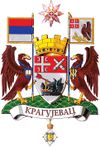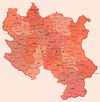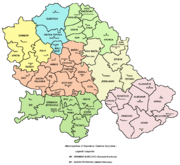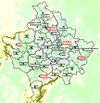Kragujevac
| City of Kragujevac Град Крагујевац |
|||
|---|---|---|---|
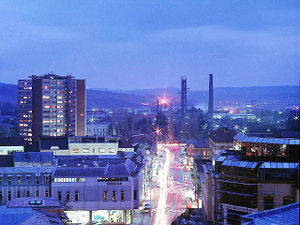 |
|||
|
|||
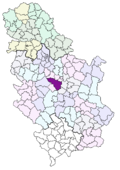 |
|||
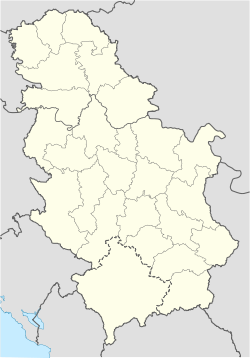 City of Kragujevac
|
|||
| Coordinates: | |||
| Country | Serbia | ||
| District | Šumadija | ||
| Municipalities | 5 | ||
| Founded | 1476 | ||
| Government | |||
| - Mayor | Veroljub Stevanović | ||
| - Ruling parties | G17+-Together for Šumadija/FES/SPS | ||
| Area | |||
| - City | 835 km2 (322.4 sq mi) | ||
| Population (2002)[1] | |||
| - City | 175 252 | ||
| - Density | 215.87/km2 (559.10/sq mi) | ||
| - Urban | 147,473 | ||
| Time zone | CET (UTC+1) | ||
| - Summer (DST) | CEST (UTC+2) | ||
| Postal code | 34000 | ||
| Area code(s) | (+381) 34 | ||
| Car plates | KG | ||
| Website | www.kragujevac.rs | ||
Kragujevac (Serbian Cyrillic: Крагујевац, pronounced ['krǎgujeʋat͡s], listen) is the fourth largest city in Serbia, the main city of the Šumadija region and the administrative centre of Šumadija District. It is situated on the banks of the Lepenica River. On the 2002 census, the city proper had 147,473 residents, while its metropolitan population was 175,252.
Kragujevac was the first capital of modern Serbia (1818–1839), and the first constitution in the Balkans was proclaimed in this city in 1835. Further on, the first full- fledged university in the newly independent Serbia was founded in 1838, preceded by the first grammar school (Gimnazija), Printworks (both in 1833), professional National theatre (1835) and the Military academy (1837).
Belgrade took the lead by becoming the seat of the throne in 1841. The University of Kragujevac was not reestablished until 1976. Contemporary Kragujevac is known for its weapons, munition, and Zastava car factory, which produced the Yugo, Florida, Zastava 10 (Fiat Punto, by licence) and Skala automobiles until Fiat bought it in 2008. The new company, called "Fiat Serbia" thereafter, pledged to invest a total of 700 million euros in the region, with the government adding 200 million euros to this.
Contents |
History
Early and medieval
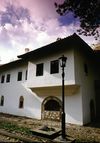
The name of the town derived from the archaic Serbian word "kraguj", which is a name used for one sort of the bird (hunting hawk), thus the name means "hawk's nesting place". Interestingly, old maps show the name as Krakow.
Kragujevac experienced a lot of historical turbulence, not always without severe casualties. Over 200 archaeological sites in Šumadija confirm that the region's first human settlements occurred 40,000 years ago, during the Paleolithic era. Kragujevac was first mentioned in the medieval period as related to the public square built in a settlement, while the first written mention of the city was in the Turkish Tapu-Defter in 1476. Turkish documents from the 15th century refer to it as a "village of Kragujevdza". The town itself gained prominence during the Ottoman period (1459- 1804) as the central point in the Belgrade Pashaluk.
Early modern period

The city is located at crossroads. Given this location, the city has been devastated many times and has suffered great losses of life in a number of wars throughout history. It began to prosper after Serbia's liberation from Turkish rule in 1818, when Prince Miloš Obrenović proclaimed it the capital of the new Serbian State and built the Amidža Konak. The first Serbian constitution was proclaimed here in 1835 and the first idea of independent electoral democracy. The first law on the printing press was passed in Kragujevac in 1870. Kragujevac, the capital, was developing and cherishing modern, progressive, free ideas and resembled many European capitals of that time.
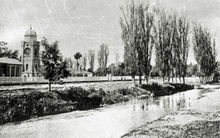
Apart from contemporary political influence, Kragujevac became the cultural and educational center of Serbia. Important institutions built during that time include Serbia's first secondary school (Gimnazija), first pharmacy, and first printing press. Kragujevac gave rise to many international scholars, professors, academics, scientists, artists and statesmen.
The turning point in the overall development of Kragujevac was in 1851 when the Cannon Foundry began production, beginning a new era in the city’s economic development. The main industry of the 19th and 20th century was military production. Kragujevac became one of Serbia’s largest exporters in 1886, when the main Belgrade – Niš railway connected through Kragujevac.
New centuries brought new wars. During World War I, Kragujevac again became the capital of Serbia (1914–1915), and the seat of many state institutions - even the Supreme Army Command was housed within the Court House building. During the war, Kragujevac lost 15% of its population.
Interbellum period
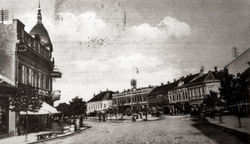
The social aspect, especially theater life in Kragujevac between the two wars was very vibrant. First cultural event in the liberated Kragujevac in 1918 was the establishment of the Theater Gundulic that worked only one season and moved to Belgrade,
Following the model of Academic Theater in Belgrade formation in 1924 at the initiative of Kragujevac scholars Academic Theater was established there, too that supported contemporary ideas, modern approach to stage, live word and repertoire, thus gaining the reputation of a serious art organization. There were many other cultural institutions in the city which began to grow into a large cultural and industrial hub of Central Serbia.

WWII and the Kragujevac massacre
Kragujevac underwent a number of ordeals, the worst probably having been the October massacre during World War II. The Kragujevac massacre was the slaughter of 2,300 to 5,000 civilians—mostly Serbs and Roma—in Kragujevac by Nazi soldiers between 20–21 October 1941.[2]. Staniša Brkić, curator of The Museum of 21 October, published a book in 2007 where he listed names and personal data of 2,796 victims.[3] The killings went on from October 19 to October 21, 1941, in retaliation for a partisan attack on German soldiers. 50 people were shot per wounded German soldier, while 100 for a dead soldier. Among the killed was a whole generation of boys taken directly from the school. The monument for the executed pupils is a symbol of the city. This atrocity has inspired a poem "Krvava bajka" ("Bloody fairy tale") by Desanka Maksimović, a well known Serbian poet from the former Yugoslavia.
Post-war city
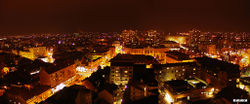
In the post-war period, Kragujevac developed more industry. Its main exports were passenger cars, trucks and industrial vehicles, hunting arms, industrial chains, leather, and textiles. The biggest industry, and the city's main employer was Zastava, which employed tens of thousands. The industry suffered under economic sanctions during the Milošević era, and was all but destroyed by the NATO bombing campaign in 1999. Despite a possible deal with the Italian auto manufacturer, Fiat, to reopen the factory, the city currently suffers from widespread unemployment.
Since 1976, Kragujevac has grown as a university centre. The University of Kragujevac includes the Faculties of Medicine, Engineering, Law, Economics, Philology, Arts, Natural Sciences and Mathematics.
Municipalities

The city of Kragujevac is divided into the following municipalities:
- Aerodrom
- Pivara
- Stanovo
- Stari Grad
- Stragari
Settlements
List of settlements in the municipalities of Kragujevac:
|
|
|
Demographics (2002 census)
Ethnic groups in the municipal area of Kragujevac (including all municipalities):
| Ethnic Groups in the Municipal Area (2002 Census) | |||||||||||||
| Ethnic group | Population | ||||||||||||
|---|---|---|---|---|---|---|---|---|---|---|---|---|---|
| Serbs | 170,147 | ||||||||||||
| Roma | 1,154 | ||||||||||||
| Yugoslavs | 401 | ||||||||||||
| Macedonians | 326 | ||||||||||||
| Croats | 204 | ||||||||||||
| Muslims by nationality | 151 | ||||||||||||
| Others | 3,197 | ||||||||||||
| TOTAL | 175.577 | ||||||||||||
Politics
|
Seats in the municipality parliament won in the 2004 local elections:[4]
|
Votes and seats in the municipality parliament won in the 2008 local elections:[5]
Veroljub Stevanovic has said that, as his Together for Šumadija-G17+ coalition is three seats short of a majority, he will discuss possible coalition arrangements with the SPS-led coalition and the "For a European Serbia" coalition that his alliance participated in for the parliamentary elections.[6] |
Notable buildings and monuments

The architecture of Kragujevac displays a fusion of two different styles—traditional Turkish (nowadays almost completely gone) and 19th century Vienna Secession style. Modern conceptions also appear throughout the city, firstly in the shape of post-war concrete (usually apartments designed to house those left homeless during World War II), and secondly the up-to-date glass offices reflecting the ambitious business aspects of modern architects.
Some important buildings and institutions in Kragujevac include:
- The old church of Descent of the Holy Spirit was built in 1818, as a part of Prince Miloš' court. Its interior was decorated from 1818 to 1822. The new belfry was built in 1907.
- The Old Parliament was built in the court of the church where the first parliamentary meeting was held in 1859. Many events of great historical importance, such as verifying the Berlin Congress decision about the independence of Serbia, took place there. After undergoing reconstruction in 1992, the building was converted into a museum.

- The Amidža Konak was built by Prince Miloš in 1820 as a residential house. It is one of the finest examples of regional architecture in Serbia. It now houses an exhibition from the National Museum.
- The Prince Mihailo Konak was built in 1860. Its architecture blends local tradition with European architectural concepts. The building is now the National Museum.
- The High School (Gimnazija) was built between 1885 and 1887 according to designs from the Ministry of Civil Engineering. It is one of the city's oldest edifices designed in a European style, in the tradition of the oldest Serbian Gimnazija from 1833. Some famous Serbian scientists, artists and politicians were educated in this school.
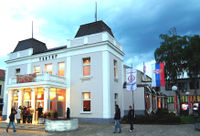
- These institutions continue to promote cultural activities in modern-day Kragujevac: Knjaževsko-srpski teatar (founded in 1835), National Library "Vuk Karadžić" (1866), Cultural and Artistic Group "Abrasević" (1904).
- The "Kragujevac October" Memorial Park, located in Šumarice, commemorates the tragic events of October 21, 1941.
- The National Museum has various displays including those pertaining to archeology, ethnic diversity, the history of Kragujevac and Šumadija and many paintings. The archeology department has a rich collection of 10,000 display items and over 100,000 study items. The painting department has over 1,000 pieces of prominent Serbian art of extraordinary value.
- The "Zastava Museum" is located within the old gun foundry and exhibits the history of industrial development in Kragujevac and Serbia.
- The Historical Archives of Šumadija collects and files the archives and issues of the seven municipalities of Šumadija and has at its disposal 700 meters of archive issues with 780 registries and hundreds of thousands of original historical documents.
- Tourists may also be interested in the range of scenic attractions nearby, including the Aranđelovac, Vrnjačka Banja, and Mataruška Banja, Karađorđe's castle, the Church of Saint George in Topola 40 km away, the Old Kalenić monastery 55 km away, the resorts of Rogot (28 km) and Stragari (34 km) with old monasteries of Blagoveštenje and Voljavca.
Sports
The city is home to the Bandy Federation of Serbia.[7] The team of Kragujevac plays against the one from Subotica.
Famous residents
|
|
International relations
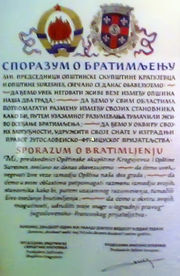
Twin towns - sister cities
Kragujevac is twinned with:[8]
| Country | City | County / District / Region / State | Date | |
|---|---|---|---|---|
| France | Suresnes | Île-de-France | 1967 | |
| Romania | Piteşti | Argeş County | 1971 | |
| Poland | Bydgoszcz | Kuyavia-Pomerania | 1971 | |
| Macedonia | Ohrid | Ohrid | 2001 | |
| Poland | Bielsko-Biała[9] | Silesia | 2002 | |
| United States | Springfield | Ohio | 2002 | |
| Italy | Reggio Emilia | Reggio Emilia | 2004 | |
| Belarus | Mogilev | Mahilyow Voblast | 2006 |
Other forms of cooperation and city friendship similar to the twin/sister city programmes:
|
Local media
Radio stations
|
TV stations |
Newspapers
|
See also
- List of places in Serbia
- University of Kragujevac
- Faculty of Economics
- Šumarice Memorial Park
- Kragujevac massacre
- Museum of Genocide
- Knjaževsko-srpski teatar
- Joakimfest
- First Kragujevac Gymnasium
- Šumadija fairground
- Gruža lake
Notes
- ↑ Popis stanovništva, domaćinstava i Stanova 2002. Knjiga 1: Nacionalna ili etnička pripadnost po naseljima. Republika Srbija, Republički zavod za statistiku Beograd 2003. ISBN 86-84443-00-09
- ↑ http://www.antiwar.com/orig/savich3.html
- ↑ Blic Online | Srbija | „Engleska krvava bajka“ u Kragujevcu
- ↑ Kragujevac election results (2004)
- ↑ http://www.cesid.org/rezultati/sr_maj_2008-lokalni/xls/Kragujevac_LOKALNI_IZBORI.xls
- ↑ "News - Politics - Kragujevac: Hunt begins for coalition partners". B92. http://www.b92.net/eng/news/politics-article.php?yyyy=2008&mm=05&dd=17&nav_id=50314. Retrieved 2009-05-05.
- ↑ http://www.internationalbandy.com/viewNavMenu.do?menuID=67
- ↑ "Kragujevac Twin Citys". © 2009 Information service of Kragujevac City. http://www.kragujevac.rs/Gradovi_prijatelji-59-1. Retrieved 2009-02-21.
- ↑ "Bielsko-Biała - Partner Cities". © 2008 Urzędu Miejskiego w Bielsku-Białej.. http://www.um.bielsko.pl/. Retrieved 2008-12-10.
- ↑ "Opole Official Website - Twin Towns".
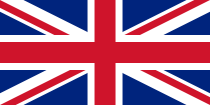
 (in English and Polish) © 2007-2009 Urząd Miasta Opola. http://www.opole.pl/miasto/index.php?option=com_content&task=blogcategory&id=20&Itemid=108. Retrieved 2009-06-18.
(in English and Polish) © 2007-2009 Urząd Miasta Opola. http://www.opole.pl/miasto/index.php?option=com_content&task=blogcategory&id=20&Itemid=108. Retrieved 2009-06-18.
Gallery
 Kragujevac pedestrian zone |
 Stone lion in Šumarice park, WWI memorial |
 First Kragujevac Gymnasium |
 University of Kragujevac |
 Zastava main gate |
 Central market place |
.jpg) Densely populated city quarters |
 City of Kragujevac |
External links
- City of Kragujevac official Website
- City of Kragujevac’s Web Portal
- City of Kragujevac’s Popular Website
- University of Kragujevac [3]
- Faculty of Economics [4]
|
|||||||||||||||||||||||||||||||||||||||||||||
|
||||||||
